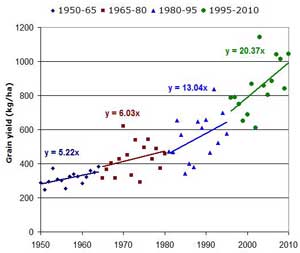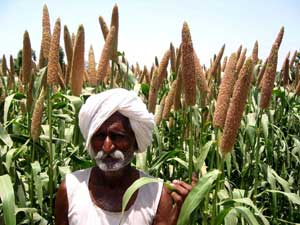
Pearl millet is grown over 10 m ha mainly as a rainfed crop in north and northwestern parts of country. These regions are highly prone to scanty and unevenly distributed rainfall and hence are always drought-prone. High temperature and low nutrient status of soils further exaggerate the deleterious effect of drought. The pearl millet growing regions are also most vulnerable to climate change as the frequency of drought is likely to increase.
Given that pearl millet grain forms the basis of food and nutritional security in rainfed regions, Indian Council of Agricultural Research (ICAR) took up the challenge to improve pearl millet productivity to ensure food supply and poverty alleviation through strategic research on genetic diversification of parental lines of single cross hybrids. There have been three conspicuous phases of hybrid development in India in comparison to pre-hybrid phase prior to 1965 (Table 1) during which improvement largely concentrated in local traditional landrace materials using simple mass selection and a few varieties were developed and released. The average rate of improvement in pearl millet productivity during 1950-65 was only 5.2 kg/ha/year (Fig. 1).
Table 1: The four phases of pearl millet improvement in India and their most distinguishing features
|
Phase |
Period |
No. of hybrids released |
Most distinguishing feature |
|
I |
1950-65 |
- |
Pre-hybrid phase, few open-pollinated varieties and mostly traditional cultivars largely grown |
|
II |
1965-80 |
17 |
Witnessed hybrid development in pearl millet, a few hybrids dominated cultivation, periodic downy mildew epidemics were common |
|
III |
1980-95 |
40 |
A large number of hybrids based on genetically diverse parental lines developed; downy mildew was largely contained |
|
IV |
1995-2010 |
62 |
A much larger number of highly diverse seed and pollinator parents used in hybrids targeting niche adaptation in different zones |
Discovery of cytoplasmic male sterility and release of male-sterile lines Tift 23A in early 1960s and its availability to Indian breeding programmes laid the foundation of hybrid breeding in India. The male-sterile line Tift 23A was extensively utilized because of its short stature, profuse tillering, uniform flowering and good combining ability. A total of 17 hybrids were released between 1965 and 1980 but there was only limited variation in pollinator and seed parents of hybrids. Cultivation of hybrids based on a few parental combinations led to downy mildew epidemics in the mid 1970s. There was only modest increase (6kg/ha/year) in pearl millet productivity during 1965-80.
The recurring problem of downy mildew epidemics in pearl millet hybrids till 1980 led to strengthening of research on the diversification of the genetic base of seed parents of hybrids. As a result, a large number of genetically diverse male-sterile lines were developed and utilized in hybrid breeding during 1980-95. Forty hybrids were released for general cultivation during this period. Consequently, downy mildew was largely contained and the productivity during this period increased at twice the rate compared to that during the previous phase (Fig. 1).

Current phase (1995 onwards) of hybrid development has put a greater emphasis on genetic diversification of both seed and pollinator parents with the result that more than 60 hybrids were released for various niche ecologies. As a result, improvement in grain productivity has further increased to 20 kg/ha/year.
Breeding programme has been fully backed-up by strong seed production and marketing of pearl millet cultivars by both public and private sectors. As a result, pearl millet has recorded 48% in its productivity since 1990 which is highest among all food crops during last 15 years.
This phenomenal success in pearl millet has been achieved despite the fact that much lesser investments, both in terms of funding and scientific manpower in public sector, have been made in pearl millet as compared to other crops like rice, wheat, maize and sorghum. In addition, the greater environmental challenges are involved in pearl millet production.

The genetically diverse hybrids are currently grown by farmers over 60% of approx. 10 m ha in country. As a result, both production and productivity of pearl millet have been on the rise. The grain production has increased from 3.5 m tones since 1960s to 9.5 m tonnes in 2010 owing to development of high-yielding single cross genetically diverse hybrids and their adoption by Indian farmers.
Investment in genetic diversification of parental lines has thus paid a huge dividend.
(Source: All India Coordinated Pearl Millet Improvement Project, Mandor, Jodhpur 342 304)








Like on Facebook
Subscribe on Youtube
Follow on X X
Like on instagram